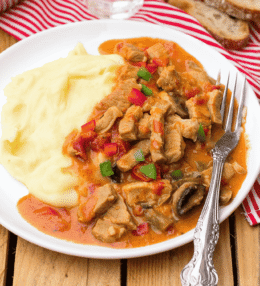
- View
Table of Contents
ToggleNasi Ulam is one of Malaysia’s most quietly captivating dishes, a herb laced rice salad that turns everyday ingredients into something truly memorable. It’s not flashy, but it carries a depth of flavour and cultural richness that makes it stand out.
Built around the freshness of local herbs and the fragrance of toasted coconut and spices, this dish reflects the land it comes from and the hands that prepare it. More than just a meal, Nasi Ulam is a reflection of tradition, community, and the beauty of simplicity done well.
Want to dive deeper into Malaysian Cuisine? Don’t miss our post on 27 Traditional Malaysian Foods to Try
What Is Nasi Ulam?
Nasi Ulam is a cold rice salad made by tossing cooked, cooled rice with a finely chopped assortment of fresh herbs and aromatics. What makes it stand out is not just the ingredients themselves but the harmony they create together.
The rice is usually prepared in advance, allowing time for it to dry slightly, which helps it absorb the herbal oils and spices more effectively. Once mixed, the result is a salad that feels both light and richly layered, packed with fragrance and texture.
Each region and household brings its own twist to the dish, which means no two plates of Nasi Ulam are ever quite the same. Some versions lean towards spice and citrus, while others highlight grassy or peppery notes, depending on the herbs used.
Traditionally, it is served at room temperature, often accompanied by grilled fish or salted egg, though the rice itself is the main attraction.
Ingredients and Taste
At the heart of Nasi Ulam is a mixture of finely shredded herbs that might include turmeric leaves, kaffir lime leaves, wild pepper leaf (daun kaduk), torch ginger flower, Vietnamese mint, and lemongrass.
These are folded through warm rice that has been left to cool, typically using fragrant white rice or sometimes brown rice for a nuttier profile. Shallots, toasted grated coconut, dried shrimp, and sometimes finely sliced chillies add crunch, umami and heat.
The flavour of Nasi Ulam is unmistakably fresh, bright, and layered. The herbs provide an uplifting fragrance that lingers long after the meal. You get a bit of everything in each bite; citrusy zing from lime leaves, the warmth of toasted coconut, a whisper of bitterness from certain greens, and bursts of savoury depth from dried shrimp.
A Taste of History
Nasi Ulam’s roots run deep into the soil of Southeast Asia, where for centuries communities have turned to native herbs not just for their culinary qualities but for their health benefits.
In Malaysia, the dish evolved from a blend of Malay culinary practices and a deep respect for foraged herbs. Traditionally, these herbs were gathered fresh from home gardens or forest edges, making the dish a true reflection of the land and its seasons.
Once a rural staple, Nasi Ulam has travelled far from its humble beginnings, finding a place on restaurant menus and in urban homes, often as a nostalgic nod to a slower, more mindful way of cooking. Yet despite its evolution, the soul of Nasi Ulam remains unchanged, a dish grounded in nature, memory, and quiet sophistication.
For those who appreciate food that tells a story through its ingredients, Nasi Ulam offers a uniquely Malaysian experience, one that continues to grow in flavour and meaning with every generation.

Malaysian Nasi Ulam (Herbed Rice Salad)
Ingredients
For the Rice:
- 2 cups jasmine rice preferably day-old, cold and separated
- 1 ½ cups water for cooking if preparing fresh rice
- ½ tsp salt
For the Herb Mix:
- 1 cup finely shredded daun kesum Vietnamese coriander or substitute with a mix of mint and coriander
- ½ cup finely chopped torch ginger flower bunga kantan, optional but traditional
- ¼ cup finely chopped kaffir lime leaves
- ½ cup finely chopped fresh turmeric leaves or substitute with young curry leaves
- ¼ cup finely chopped lemongrass white part only
- 1 tbsp finely grated fresh turmeric
- 1 tbsp finely grated galangal or ginger
- 3 bird’s eye chillies finely sliced (adjust to taste)
- ½ cup grated coconut dry toasted until golden
- 2 tbsp kerisik toasted coconut paste optional for deeper flavour
- 2 tbsp finely chopped shallots
- Juice of 1 lime
Optional Garnishes:
- Fried shallots
- Hard-boiled eggs halved
- Sliced cucumbers or herbs on the side
Instructions
- To begin, if using fresh rice, rinse it thoroughly until the water runs clear. Cook with the 1 ½ cups of water and salt in a rice cooker or pot. Once done, fluff it and allow to cool completely. Ideally, use rice made the day before for a firmer, non-sticky texture.
- While the rice cools, prepare the toasted coconut. In a dry pan over medium heat, toast the grated coconut until golden brown and fragrant. Stir constantly to prevent burning. Set aside to cool.
- Next, toast the kerisik if using. Continue in the same pan by gently frying an additional few tablespoons of grated coconut until deeply golden, then grinding it into a coarse paste. This adds richness and depth, especially if you're not adding meat or seafood.
- Chop all herbs very finely. This is key for the signature texture and even distribution of flavour. Pay close attention to fibrous herbs like lemongrass and kaffir lime leaves, they must be minced finely or they’ll overpower the dish.
- In a large mixing bowl, combine the cooled rice with the toasted coconut and kerisik. Gently fold with your hands or a wide spoon, loosening any clumps and ensuring even mixing.
- Add the chopped herbs, grated turmeric, galangal, bird’s eye chillies, and shallots to the rice. Mix gently but thoroughly to ensure all ingredients are evenly distributed. Avoid overmixing which can break the rice.
- Squeeze the juice of one lime over the rice mixture. This brightens the flavours and balances the earthy, spicy notes. Mix again gently.
- Taste the Nasi Ulam and adjust seasoning. You may add a pinch more salt or a few extra chillies depending on preference. Traditional Nasi Ulam should be punchy, fresh, and lightly spicy.
- Transfer the rice salad to a serving platter. Garnish with fried shallots, halved hard-boiled eggs, or extra fresh herbs. Serve at room temperature with cucumber slices or as part of a larger Malay spread. This dish pairs beautifully with grilled fish or sambal for those who want added heat.
Nutrition
You May Also Like







Leave a Review